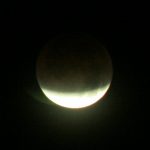On behalf of the RASC Vancouver Centre Council, and on the occasion of the publication
of this, our first edition of NOVA for 2012, I would like to extend best wishes to our
members and public for a happy and fulfilling New Year, one that includes an abundance of
astronomy in all of its forms, especially clear skies!
If you are reading a hardcopy of this edition of NOVA, then you quite likely picked it up
at our first public lecture of the year, which is being held at the UBC Hennings Physics
Building. We will be hosting Prof. Ray Jayawardhana, Professor and Canada Research
Council Chair of the University of Toronto, for our January 12 lecture. Prof. Jayawardhana’s
presentation is entitled Rocks, Ice and Penguins: Searching for Meteorites in Antarctica. Be
sure to look elsewhere in this edition of NOVA for a backgrounder on our speaker, who has
been hailed by Wired Magazine as “a rock star” of astronomy!
This lecture promises to be just the start of another year of presentations by A-list
speakers, on a diverse range of topics! Our top-flight speaker program is one of the great
strengths of RASC Vancouver’s programming, but is just one of our many services that
benefit our members, and which contribute to the community at large.
If you are a member of RASC Vancouver, then you probably already know the broad
outlines of the other priorities that council has set for our 2012 programming, which we
have carefully chosen in order to effectively concentrate our efforts in four key types of
activity: Public outreach; Observing Programs; Membership Building; and Web Presence.
Council has set specific goals within each of these four areas, whilst we keep on the lookout
for other opportunities that may arise during the course of the year.
For outreach, we intend to invest in our partnerships with the SFU Observatory (coming
soon to a Burnaby campus near you!) and the BCIT Planetarium, including using these
venues to reintroduce our very successful “What’s Up?” program for newcomers to
astronomy (especially young ones!). The “What’s Up?” program was established last year
as an “add-on” to our monthly lecture series, but will instead be offered this year a series of
special events, independent of our speaker program, so as to better serve a young audience.
To reinvigorate our observing program, we will establish a regular series of observing
nights, using Twitter to link participants to these events in real time (more on Twitter
below), along with a series of clinics on telescope use, astrophotography, and other areas
of interest (looking to our members for direction here). We will also continue to improve
access to our valuable observatory, the AOMO in Maple Ridge.
To build our membership, we will survey members and our many non-member guests to
establish what we need to do to bring more value to our existing membership, and to entice
newcomers to our society. The June 5 transit of Venus promises to be a extraordinary
opportunity to showcase Vancouver Centre to a large public audience, allowing us to
highlight the expertise of our membership with appearances on local TV and radio
broadcasts, and in interviews by print media, and accentuating our capacity for community
engagement by a massive show of force on event day! We are already gearing up for
this fabulous occasion! If you are a member of Vancouver Centre, and are interested
in becoming involved in our public presence, there is no better way to do so than by
contributing to our Venus transit effort, and no better time to step forward than now! I
heartily encourage you to contact Vancouver Centre’s Event Coordinator, Suzanna Nagy, at
[email protected].
Turning to our fourth and final priority for 21012, which is to improve our electronic
presence, we will establish Facebook and Twitter as prime social networking tools (in
addition to our successful Meetup site), especially for linking our members in real time, and
we will increase content on our much improved web site, http://rasc-vancouver.com.
RASC Vancouver Centre also has an important new challenge in 2012. This concerns a
central part of our efforts, which, as I described at the top of this column, is to provide a
monthly speaker to our membership and the general public. Over the past 40 years, our
venue for these meetings has been the HR MacMillan Space Centre, where we were not
charged for meeting space. Owning to a difficult financial situation, the Space Centre will
now charge its standard rate for nonprofit organizations, of $640 per meeting. Council has
unanimously agreed we cannot afford this fee without serious compromise to the rest of
Vancouver Centre’s efforts.
Fortunately, we have much less expensive alternatives that we can use while we look for
a longer-term solution. We have already made ongoing arrangements with SFU and UBC,
which will provide us with meeting space at minimal or zero cost, and with BCIT, which
has economical rates, and which suits our priorities for this year. The Space Centre will
continue to offer us free use of the auditorium for speakers that they think will appeal to a
broad enough segment of their audience. The Space Centre has also pledged to revisit our
relationship once they return to fiscal health
At this point, we have established the venues for the first three lectures of 2012, which
all promise to be of outstanding quality, and on exciting and timely topics. Following
our January 12 lecture at UBC by Prof. Ray Jayawardhana, our Thursday February 9
presentation will be at the Space Centre, where we will host Dr. Ed Krupp, Director of
the Griffith Observatory in Los Angeles, and our Thursday March 8 lecture will return to
UBC, where will we host Dr. Catherine Johnson of the UBC Department of Earth and Ocean
Sciences, and a member of the MESSENGER spacecraft science team. For April and beyond,
locations will be announced as soon as we have determined the venues. Notifications will
be sent to membership by email, and will be posted on Meetup. In general, please consult
our Meetup site on a regular basis for more information, as it becomes available: http://
www.meetup.com/astronomy-131.
Finally, all of us council would like membership and our public to know that we are actively
working on an opportunity to establish a new permanent base of operations, one that may
turn out to be remarkably close at hand.
There is much to look forward to in 2012 at RASC Vancouver! All of us on council look
forward to you at more of our monthly lectures, and our many other events.
Howard Trottier
President, RASC-VC
Professor of Physics, SFU








